How can you not be intrigued by a place called the last Shangri La, a country measured by Gross National Happiness, a land of thunder dragons and snow leopards? When you have a chance to visit the reclusive Himalayan Kingdom, you have to go…and deal with the consequences later.
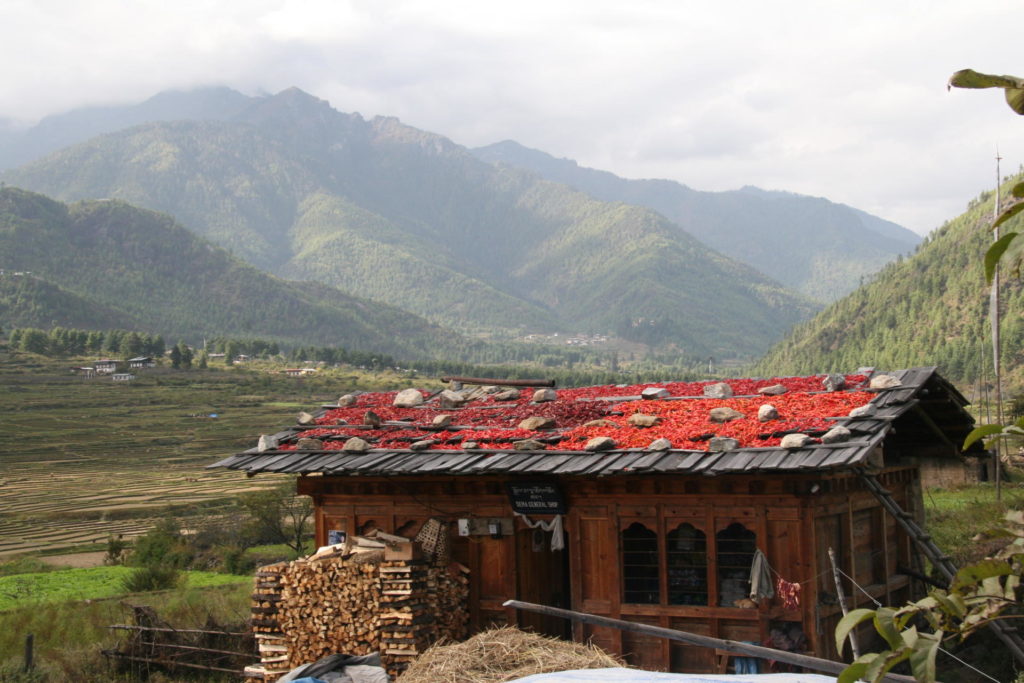
When the pilot announced Mt. Everest was right outside the window, it finally hit me I was in the Himalayas. My friend Tim and I stepped off the plane in Paro (2,250 meters) on a late October morning under scattered clouds as men milled about in knee-length Bhutanese kimono-style garments with argyle socks pulled to their knees and fine leather dress shoes that seemed a tad too big.
One young man, sporting stylish Rayban sunglasses, was our guide Ugyen. He and our driver Pasang led us to the new van in which we would spend many hours crisscrossing Western Bhutan. But right now we were headed to our hotel to wait for our friends to arrive from Nepal.
The Hotel Gantey Palace, which really was once a palace, proudly overlooks the Paro Valley. The hotel’s stone floors, dark wood beams and white walls decorated with colorful, intricate Bhutanese patterns and tapestries made for an excellent introduction to Bhutanese architecture and design.
We lounged on the benches in the well-kept garden, looking out over rice fields, the town of Paro and the massive Paro Dzong (monastery) on the opposite hillside. In the other direction, toward Tibet, you could feel the immensity of giant mountains unseen.
After Tokyo’s bright neon lights, packed subways and clamoring pachinko balls, the pleasantness of this place was almost unsettling. Like trekkers acclimating to altitude, we needed a few hours to let our pulses adjust to the pace of Bhutan. The feeling we had somehow slipped into a postcard became a recurring theme.
Now and Then
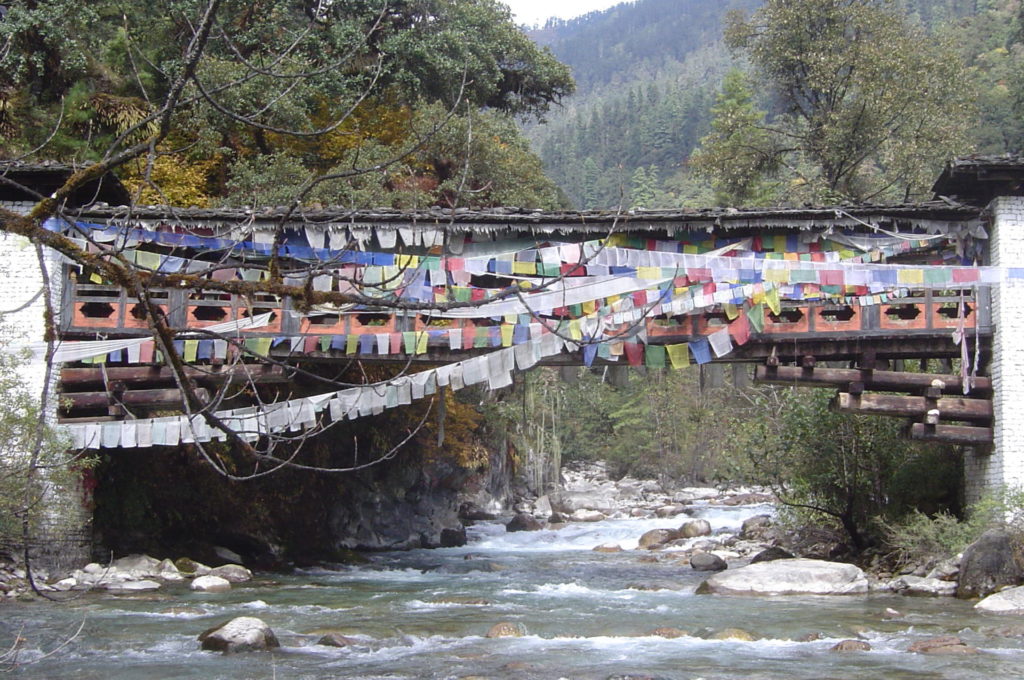
Bhutan is the smallest country in its region. It is fully aware of its precarious location between giants India (a close ally to whom it sells much of its hydroelectric power) and China, and fully committed to preserving its culture and traditions while carefully embracing modernism.
Satellite TV came to the country less than a decade ago, royal mandated democracy just over a year ago and, although there is no longer a fixed limit to the tourists allowed in Bhutan, the numbers are somewhat self-regulated by the amount of flights and hotel rooms available, especially during spring and autumn peak seasons.
You must, however, join an official tour to travel in the country, which costs up to US$200 a day, depending on the activities you choose, the number in your group and the tour company. This may seem steep to the typical backpacker, but consider it covers your guide, a driver, transportation, comfortable accommodations and meals and its not unreasonable.
However, Bhutan is not going after the shoestring traveler anyway; they seem quite happy to let India and Nepal have that market. This is a kinder, gentler version of Himalaya travel, especially if you have a relatively short trip, such as ours, limiting you to exploring the more popular western part of the country.
We had just a little more than a week, so our tour would be “Bhutan Lite.” There would be no two-week “Snow Man” treks or tramping through the even less populated eastern region. We’d stay out west and enjoy some stunning day-hikes, countless dzongs (monasteries), visits to cultural museums and national parks, and mix in some light adventure—a mellow rafting trip in Punakha and some mountain biking in the Haa Valley.
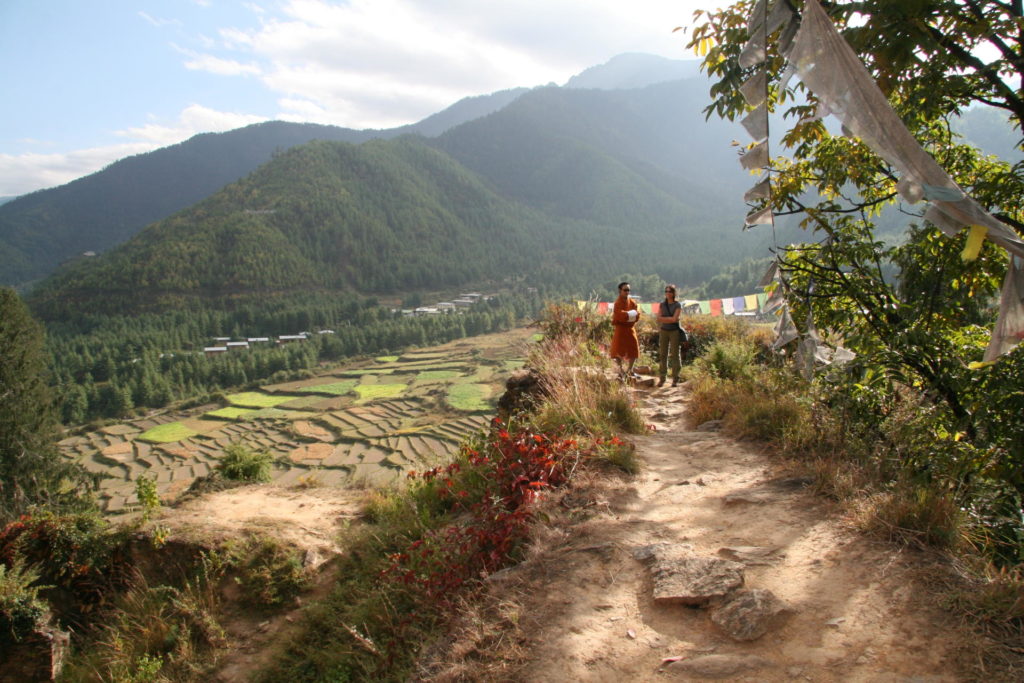
Paro to Thimpu
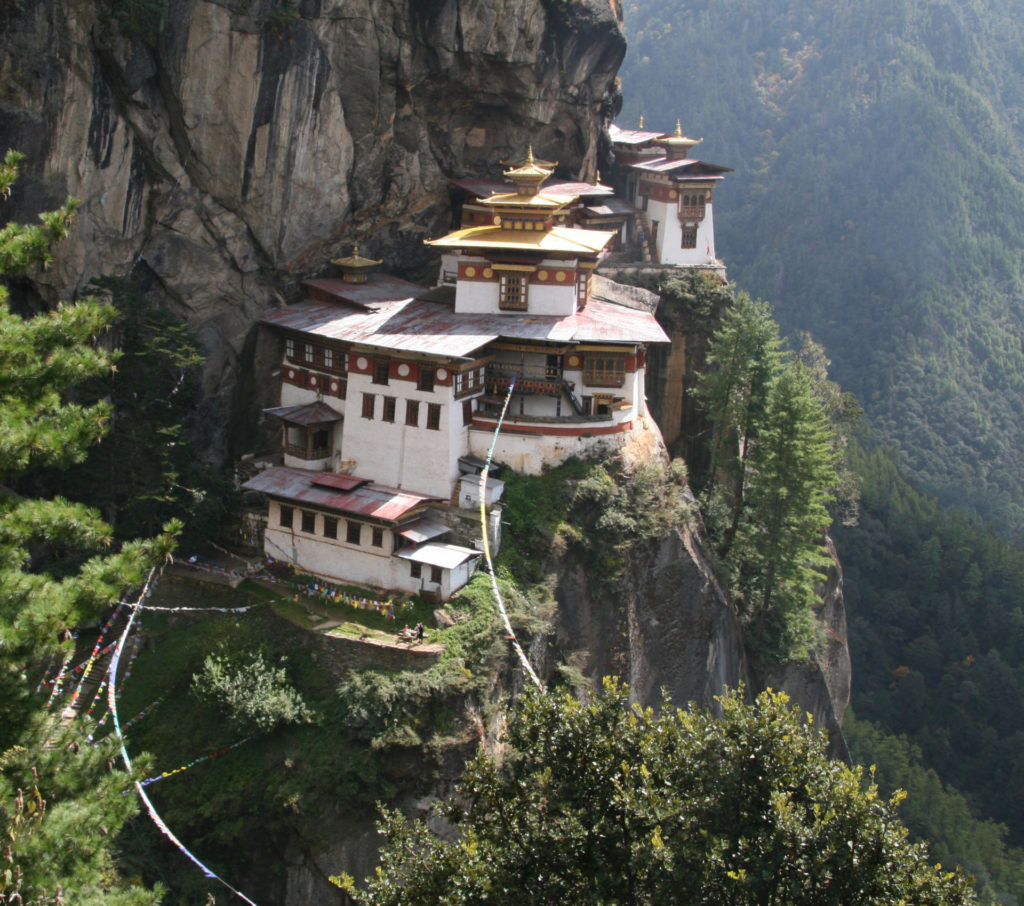
From Paro we visited the famed Tiger’s Nest Monastery just outside of Paro. This is Bhutan’s most recognizable landmark, perched surreptitiously on the side of a cliff, with prayer flags crisscrossing high above the valley floor and flapping in the wind.
To get to the trailhead, you drive past terraced rice fields and houses with corrugated roofs covered in red chilies drying in the sun. The hike isn’t especially difficult, and there is a teahouse along the way where you can rest and enjoy an unobstructed view of the monastery while having lunch.
If you are traveling in western Bhutan, you’ll come to know the road from Paro to Thimpu well. It was under construction while we were there, so it was bumpy, dusty and slow moving but, fortunately, it is now completed.
A hilltop park covered in prayer flags overlooks Bhutan’s capital including the traditional government offices and official residences. Stroll the bustling market and take time to relax in some of the great cafés in town while reading up on your Bhutanese history.
After a few hours in the van, Tim and I decided to stretch our legs and “toss the disc” in the mostly vacant town square. Within a few minutes, some curious kids started hanging around. A short time later we had dozens of children running around the square chasing after our Frisbee.
Children in Bhutan learn English from an early age, and it seemed as if everyone we met under 30 could speak some. The Frisbee made a great icebreaker, and the kids laughed at one another as they tried to throw this strange object, practicing their English on us as they ran around the square.
When we finally had to leave, my heart almost cracked when one of the smallest girls, who had stayed a bit closer to me to avoid getting ran over from some of the older kids, looked up and said “Will you be my friend?”
I bent down to reply, “I would be very happy to be your friend.” With a giggle, she ran off to join her friends as we waved goodbye.
Thimpu to Punakha
The drive to Punakha takes you over Dochu La (3,140 meters) where you can enjoy panoramic views of the Himalayas if you happen to be there on a clear day. There’s a powerful telescope here, a gift from the Kyoto Alpine Club after making the first ascent of Masang Gang (7165m, 1985). Most people stop at the restaurant just below the pass for tea and to try and catch a glimpse of the mountains.
When we arrived at our inn, the colorful proprietor was sitting in the dining room in an old white tank top and holding court for a group of German guests. After we sat down at our table, he saddled over and offered us some of his special homemade brandy which he seemed to have been sipping himself.
He called himself the modern-day “Divine Madman,” referring to the famous old monk who was a drinker and womanizer and, after a few hours, he had us convinced.
But we came to Punakha to see Punakha Dzong. It was impressive wandering the grounds of the monastery, but we also planned to raft down the glacier-fed river and float under high wire bridges strewn with prayer flags, past terraced ride fields and by the impressive dzong.
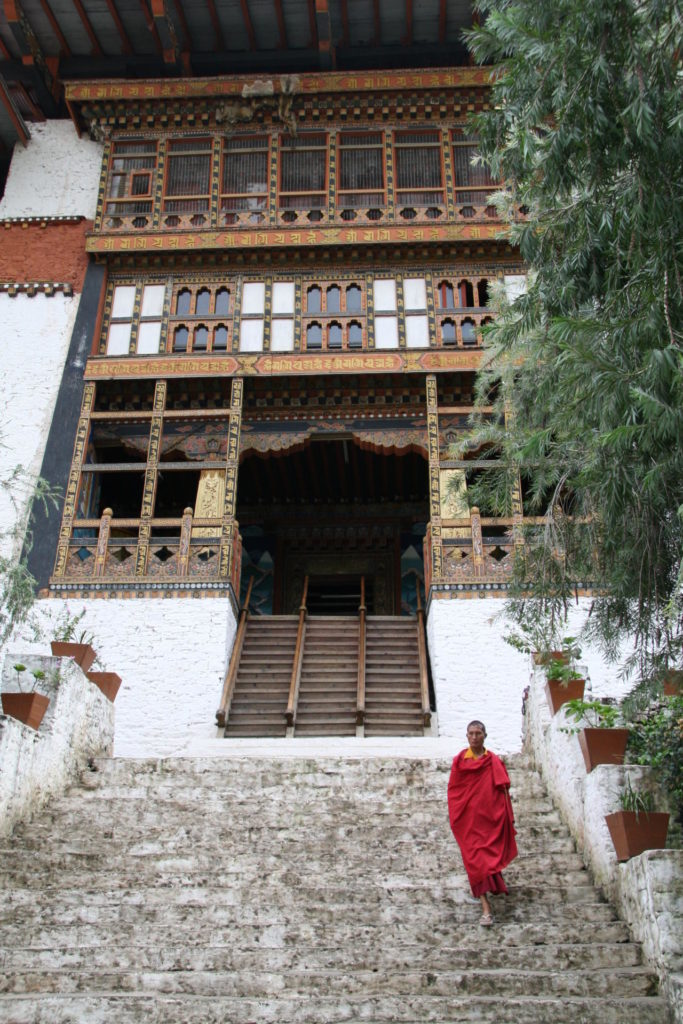
Punakha to Haa
Perhaps the most unexpected highlight of the trip was the Haa Valley. The drive followed along a steep river canyon, at some points above the cloud line, before we descended into the valley, which opened for tourists as recently as 2001. Military posts, in town and up the valley, are reminders there is easy access to Tibet. They keep a weary eye on their industrious neighbor who no doubt would cherish Bhutan’s rich natural resources.
There are some great hikes out of Haa to secluded temples and monasteries, but we heard there was some good mountain biking as well. How could we pass up starting a downhill higher than the top of Mt. Fuji and then riding cross-country to the foot of Tibet?
Our guide, Tshering, was waiting for us when we woke up the next morning with his Toyota truck filled with suspension-fitted bikes. We drove to the top of Cheli La (Cheli Pass, 3,899 meters) the highest point you can reach by car in Bhutan. To put it into perspective, the top of Mt. Fuji is 3,776 meters high. We rode a bit higher up a dirt track to a hilltop filled with prayer flags to make sure we started above 4,000 meters.The downhill was hand-numbingly great. Amazing views and lots of speed.
We dropped into the pleasant town of Haa, then followed the river up another valley where we would meet up again with Tshering. We found him waiting next to his 4WD pick-up in a wide-open field that seemed to rise all the way up to the edge of the valley, and the last Bhutanese army post at Damthang.
On the other side of the soaring mountains was Tibet. We lunched among grazing yaks and dread-headed wild dogs that roamed the valley keeping the wolves away. Like most of the wild dogs we met, these were friendly and, before long, Tshering had one rolling on its back as he rubbed its belly with his shoe.
Haa to Paro
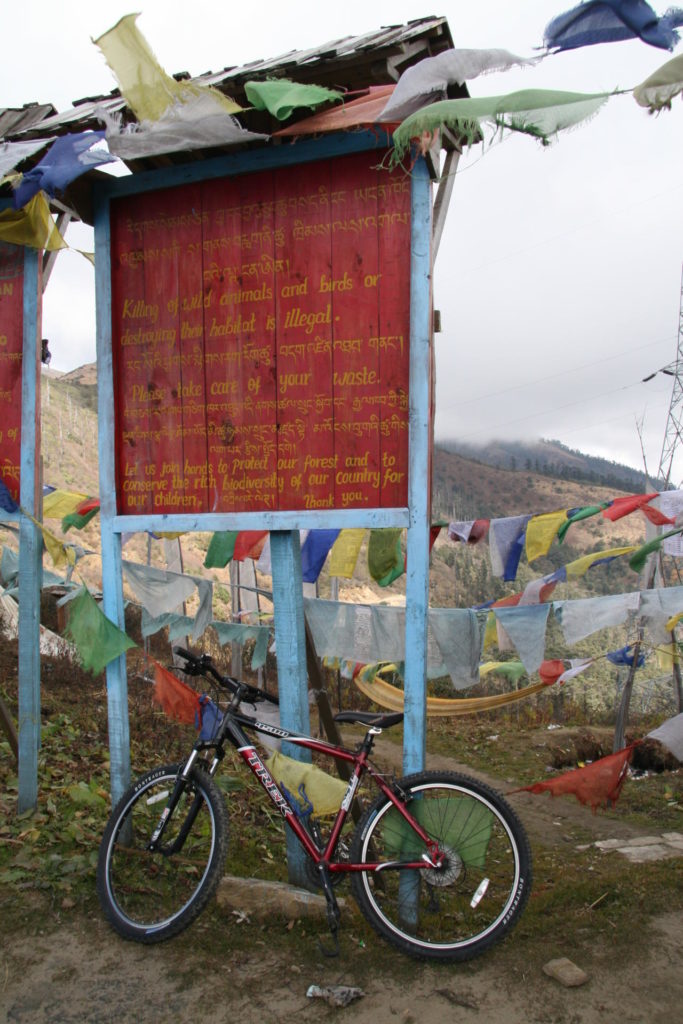
The next day we drove over Che La, stopping to catch a glimpse of Jhomolhari (7,314 meters) before winding down the road to Paro. We had made it full circle and had one last night at Gantey Palace where we had spent hours looking down across the valley at farmers working in the flat rice fields as cows and yaks fed on the stalks. Our eyes always ended up landing on Paro Dzong and, on our final day in Paro, it was time we made a visit to the monastery.
We wandered up stairs, through stone passageways, mud walls, placing hands on prayer wheels, contemplating the simple life of the ochre-clad monks slipping in and out of doorways, carrying rice and water to places unseen.
I walked past one room filled with shaven-headed children wearing the same flowing robes of their elders. Like kids the world over, they were full of mischievous, unbridled energy, bouncing off walls, wrestling and chasing each other around.
A serious looking monk appeared, sufficiently chastising them to temporary attention. He walked by me and flashed an exasperatedly wry look, gently shaking his head if to say, “Kids will be kids…”
We walked back across the wooden bridge at the entrance of the dzong, where tattered and faded prayer flags flapped in the wind. On the other end, Pasang waved us over to where a picnic lunch was spread under a big tree next to the river. It was the last time our group would be together before going our separate ways.
We sat there mostly quietly, with a few reflective comments, discussing all the things we wanted to come back to see, trying not to think about commitments once we returned. The river flowed down from the mountains past this very spot as it has done for centuries. The bright sun careened off the white mud walls of the Paro Dzong as the faint laughter of children playing in the water upstream drifted down.
On the way back to the van, I pointed out some marijuana plants growing wild along the path to Ugyen, who looked back through his designer shades, smiled and said, “We feed that to the pigs.” I couldn’t help but think even the pigs in Bhutan are happy.
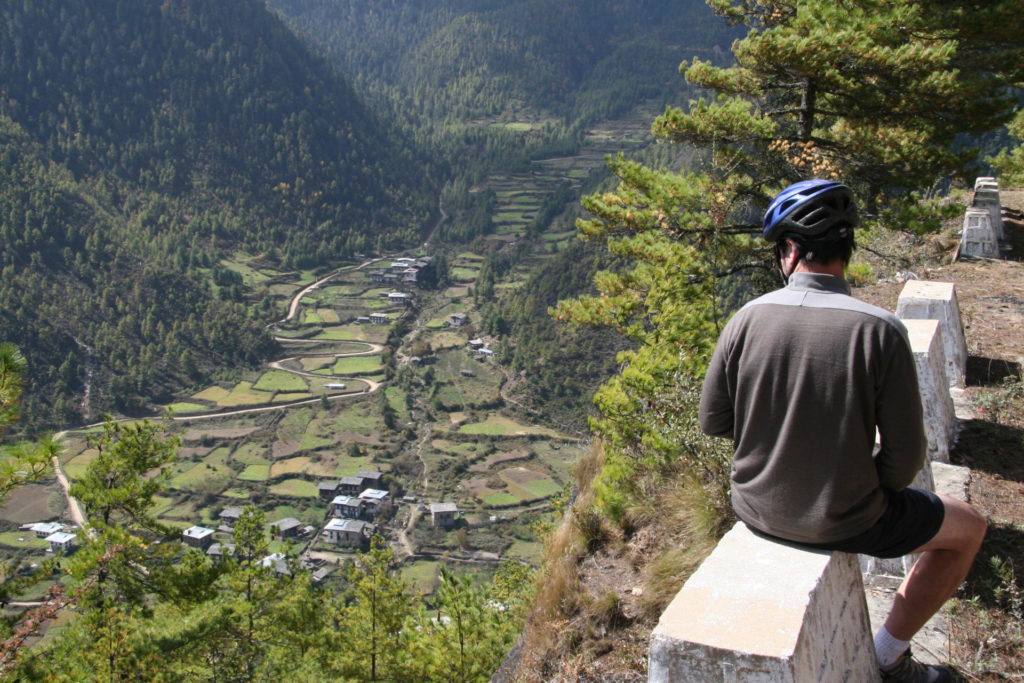
DRUK TIPS
Love is blind…especially in the dark. Breaking and entering—or love? Spend enough hours in a van and the conversation will take you to some interesting places, such as the tradition of “Nighthunting” which primarily takes place in rural areas (there are many) when a young man tries to sneak into a house late at night in a brave act of courtship. Risks include angry fathers, stick-wielding grandmothers and, if you are really unlucky, an unfriendly dog. It pays to make sure you get the right room…or at least the right house.
Divine Graffiti. It will not take you long to notice a certain male organ painted in various shapes and sizes on the walls of the houses of seemingly respectable Bhutanese families. This is not the act of a rogue graffiti artist, and these fine people are not miscreants; they are simply honoring one of Bhutan’s most beloved monks, Drukpa Kunley, better know as the “Divine Madman,” an irreverent priest, known for bawdy songs and lewd poems and lover of wine and women.
A la carte. Independent travelers may tire of the buffet restaurants on the tours. Schedules are tight and catering to everyone’s tastes is difficult for guides, so you will need to be flexible. But if you want to have a more leisurely dinner and order off the menu (respect the chilis). Talk to your tour company before the trip and your guide once you get there.
Takin. Visit Bhutan’s national animal at the Takin Wildlife Reserve. It’s said the animal was created after a big feast by the Divine Madman who took the head off a goat and placed it on a cow.
Trekkers Shangri La. World-class trekking tours range from moderate multi-day treks to grueling trips of 20 or more days, fully supported with guides, porters and cooks. On most tours you only carry a daypack and water, stay in canvas tents and enjoy gourmet meals after long days on the trail.
Festivals. Some people come to Bhutan just for the festivals. Check the calendar before you go and plan your trip to coincide with one of the celebrations.
Royal Democracy. At the bequest of the king, Bhutan had voluntary democratic elections in March, 2008. Voter turnout was 80%.
Thunder Dragon Airlines. “Druk” means Thunder Dragon and Druk Air has regular flights from India, Nepal and Thailand. If you are flying from Katmandu to Bhutan, enjoy some amazing Himalayan views. Web: www.drukair.com.bt
Fall and Spring. The most popular time to visit Bhutan is in autumn from mid-September to mid-November. Spring is the second most popular season. There is more rain, but also some beautiful flowers in bloom.
Bhutan Descents. If it is serious adventure you are after, join a 17-day world-class white water odyssey in this magical land. Trip Date: Nov. 13-30. Price: US $6,8000 For more info contact Pat O’Keeffe at hoa@rafting-hoa.co.jp.




